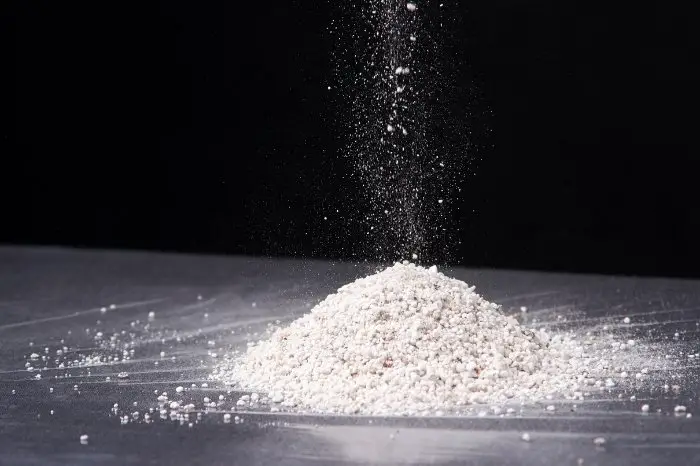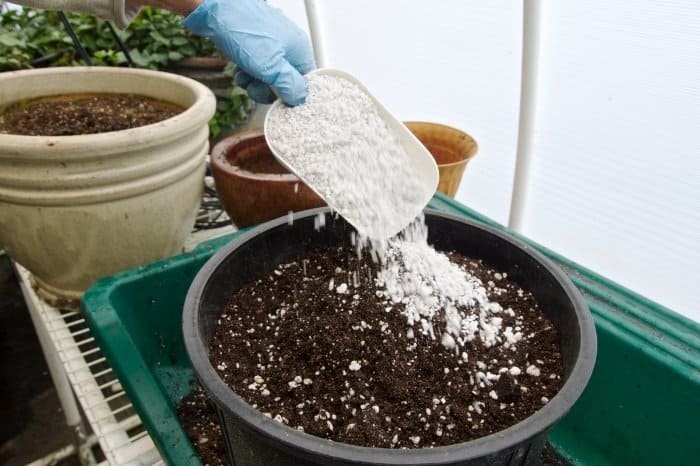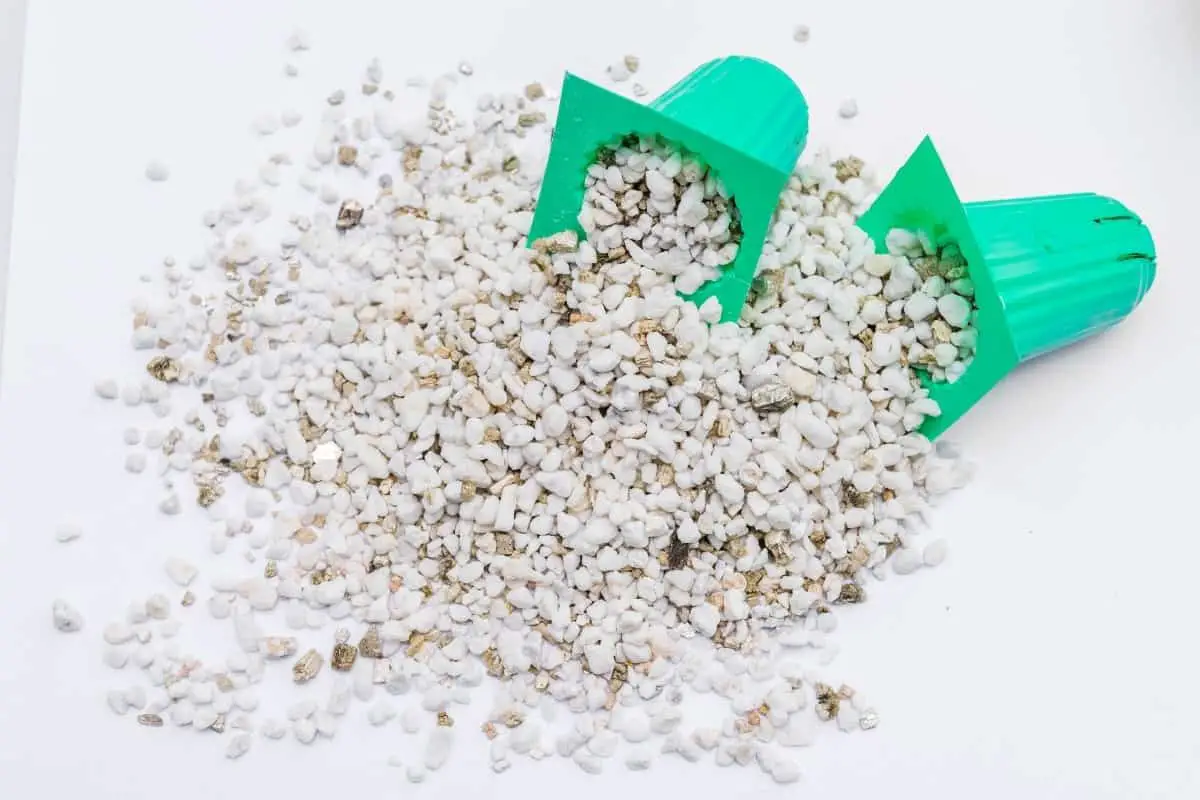Last Updated on January 21, 2022 by
Before you go looking where to buy perlite, let’s look at what it is and its importance to the soil as well as how it’s manufactured.
Have you ever looked at the potting soil and noticed little white specks that look like Styrofoam or even tried to pop them? If so, you are among many who wonder what these little things are.
Although they look similar to Styrofoam in appearance, these little white balls aren’t Styrofoam in any way. They are bits of expanded rock called perlite. They are very valuable in gardening and horticulture in general.
What Is Perlite?
Perlite is a natural mineral that exists in nature as a type of volcanic glass. It forms when water saturates volcanic obsidian glass over a period of time.
Natural perlite is grey or black in color and there is no structure of shape to it, unlike the manufactured one that is in crystal formations. It is as dense as the volcanic rock and weighty in its native format.
Excavated perlite contains the following elements:
- 5% water
- 75% silicon dioxide
- Sodium oxide
- Aluminum oxide
- Magnesium oxide
- Potassium oxide
- Calcium oxide
- Iron oxide
Perlite is a non-renewable resource because it is a naturally occurring mineral. There are hotbeds of perlite production with the most operations being in Greece, Turkey, Japan, and the United States.
This mineral is an inexpensive material that has plenty of uses including gardening, masonry, ceiling tiles, etc.
For this post, we will concentrate on using perlite in gardening. Did you know that those little white balls or perlite we see in the soil mix go through processing from its natural mineral harvested at the volcanic mountains?
Check out The Best Potting Soil for the Christmas Cactus
How Is Perlite Manufactured?
The little white balls you see suspended in your soil mix are known as volcanic popcorn. Perlite is mainly water and when heated y the manufacturers at high temperatures, it pops just like the normal popcorn does.
The manufacturers start by crushing the perlite and then bake it in large ovens at 1,650 degrees Fahrenheit.

The heat softens the mineral structure and turns the trapped water inside the perlite into steam and expands it. As the steam escapes, it causes the expansion of the material leaving behind the perlite used in agricultural applications.
During this heating process, the perlite expands up to 16 times more than its original size. The tiny white Styrofoam-looking balls are sterile, porous, and stable after cooling.
Read more about Best Potting Soil for Aloe Plants
Where Can I Buy Perlite?
You can buy perlite in significant amounts from your favorite outlets and online stores like Lowes, Home Depot, Amazon, eBay, your local nurseries, and hydro shops.
Perlite is very affordable and you can buy large bags of perlite for little money. We recommend buying in bulk and storing the rest for your continued use. You will find many uses for it around the garden as the growing season unfolds.
Don’t be afraid of overusing perlite. It’s an excellent soil amendment that cannot be overdone easily and it is safe to store it for long. When buying perlite, choose 100% natural without any mixed elements and mix it with soil, soilless growing media, or fertilizer to your liking.
10 Liters Organic Coarse Perlite for All Plants – Horticultural Soil Additive Conditioner Mix
How To Use Perlite In Gardening?
There are several ways you can use this mineral around your garden.
Use it as a source of surface treatment. Scatter loose perlite over your flowerbeds to act as a wicking agent. The mineral will eventually work itself into the soil, improve its water retention and draining capabilities.
Fortify your soil mix. Adding perlite to your loam soil and peat moss enhances the aeration and drainage of your soil. It also provides a stable growing medium that absorbs the nutrition of your plants.
Rooting your cuttings. Perlite encourages root growth in a much faster way in new cuttings. Place your cuttings in a Ziploc bag with moistened perlite. The moisture will keep the cuttings alive while it starts to form new roots.

Conclusion About The Benefits Of Buying Perlite
Most gardeners do not know the benefits of using perlite to improve aeration and drainage to their soil. When you add this mineral you will begin to notice a significant difference in the health of your garden during summer.
If you are looking for a soil amendment that improves your growth and production of your seedlings and plants, look no further, perlite will give you all these benefits. Your cuttings and your potting mix will never be the same if you use this mineral.
Perlite is the secret weapon for successful gardening all around the world. Add it to your soil today and you will reap the benefits.
FAQs
What can perlite be used for?
Perlite is a very versatile material that can be used in a variety of applications. Perlite is an excellent air-entraining additive and can be used in place of coarser media, such as vermiculite or peat moss, to enhance the ability of plants to hold water. It is also an excellent carrier for fertilizer, and can be added to soil to help make it more friable and improve drainage.
Perlite has also been used as a soil amendment to replace sand or clay, but this application is not recommended due to its tendency to form clods which may interfere with plant growth. Perlite is typically used in a two-step process. First, a layer of Perlite is applied to the soil surface using a spreader box. The Perlite is then tamped down with a roller to a depth of one-half inch or more.
Perlite can also be used to cover large areas of bare soil. For example, it can be mixed with peat moss and used to cover a new lawn. The use of Perlite in agriculture has been studied in some detail. It has been found that Perlite improves the water retention capacity of soil, but it does not appear to improve the water holding capacity.
What is it made out of?
Perlite is a very common ingredient in many DIY home projects. It is a naturally occurring volcanic glass that is widely used as a soil amendment.
Where do you find perlite?
I know it is sold in the big box stores, but I don't see it anywhere else.
How do you make homemade perlite?
To make your own perlite, you need to start with a mixture of sand and vermiculite (or perlite) that has a particle size of less than 0.5mm. The most common way to achieve this is to use a sieve to separate the two materials.
Caroline is a gardener who loves to get down to the nitty–gritty of gardening. She proudly proclaims herself as a ‘dirt worshipper‘ and can often be found deep in the garden, covered in soil and singing to her plants. As a self–proclaimed ‘plant whisperer‘, Caroline believes that plants need love and attention just like any other living thing, and she loves to give them both. When she‘s not tending to her garden, you can often find her researching the latest gardening trends, or teaching others how to make their gardens thrive



